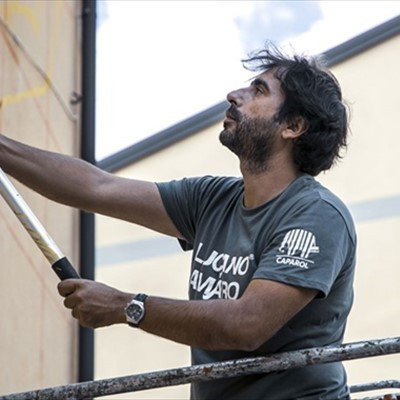Progetto Arteria was created thanks to the contribution of the Regione Puglia with the SThAR lab programme. Coordinated by Giovanni Panaro S.p.A. for the Municipality of Alberobello (BA), it is entrusted to the artistic direction of art historian Sara De Carlo and the work of artist Alessandro Suzzi aka Gods in Love.
We are in Alberobello (BA), a town known all over the world as the Capital of Trulli. The aim of the project is to bring a work of contemporary public art to such a popular place. The work is dedicated first and foremost to the people who live on these streets every day and who deserve to be able to enjoy new forms of art to which they have never been used, but also to all those who visit our city from near and far and can add an extra stage to their travel itinerary.
The wall chosen for this work is the main facade of the Scianni-Ruggieri Municipal Stadium, conceptually connected to the Community Library of Alberobello. The two places have in common their nature as spaces of aggregation, especially for young people, where to cultivate and increase skills. Progetto Arteria will seek to create an indissoluble thread between the two cultures: the sporting and the artistic-literary.
Just as arteries carry oxygen-rich blood away from the heart, so Progetto Arteria aims to bring lifeblood - represented by art in all its forms - to the less touristy areas of the town, sprinkling the fabric of the city with a cultural alternative that makes these places a point of reference.

Alessandro Suzzi (Cosenza, 1980) is a street artist and art director. His artistic work began when he was very young with the publication of various novel graphics with independent Apulian labels, after which he became passionate about urban art, writing and punk and hip hop culture. In 2004, with the NYSF Crew, his work was published in Graffiti World - Street Art from five continents by Nicholas Ganz.
After moving to Bologna for his university studies, Suzzi began a prolific production of oil paintings. In 2010, the Gods in Love art project was officially launched, with which he produced works all over Italy and abroad. The aim of the project is to represent the most ambiguous and unknown biblical events, reading them in a secular key and with a very personal aesthetic interpretation.
At the same time, in addition to his work as an artist, Alessandro Suzzi is also involved in the creation and management of cultural events linked to the world of public and contemporary art: in 2015 he was artistic director of the public art festival Verso Sud and from 2018 to 2021 of the public art festival Appartengo, held in Stigliano (MT).

Sara De Carlo (Alberobello, 1990) is an art historian and critic, with a degree in contemporary art history at La Sapienza University of Rome. She has collaborated with the Museo Nazionale Romano (Palazzo Massimo alle Terme, Palazzo Altemps, Terme di Diocleziano, Crypta Balbi) and with the art photographer Claudio Abate. She curated the following exhibitions: Visioni del corpo nello spazio urbano - Ennio Buccioli (2021, Museo Civico di Putignano BA), Giano - Agrimi / Giangrande (2019, Fortino di Sant'Antonio Abate in Bari), Manhattan - Nino Giammarco (2016, Studio Abate in Rome), Paesaggi: uno sguardo sul corpo (2015, Marmo in Rome). She also wrote for the exhibitions: Scarti - Franco Farina (2021, Festival della sostenibilità di Crispiano TA), Progetto Monet (2021, Fondazione Museo Pino Pascali a Polignano a Mare BA), People - Nico189 (2020, Wallness Gallery in Bari), Nudisti Timidi. Anonimo Assoluto - Kawamura Gun (2016, Galleria 291 est in Rome), ll Mattone: 6 Outsider (2015, Museo MLAC - Museo Laboratorio di Arte Contemporanea in Rome).
In 1951, Pier Paolo Pasolini, under the pseudonym Paolo Amari, wrote the article I nitidi trulli di Alberobello for 'Il Quotidiano', referring to the town as the masterpiece of Apulia. Visitors, just like Pasolini himself, are always surprised and fascinated by the idea that one can live in such a fairy-tale atmosphere, made up of the whiteness of spontaneous architecture. This beauty and uniqueness is paid homage by the large work by Alessandro Suzzi aka Godsinlove on the entrance wall of the Stadio Comunale. The grey facade is filled with the team colours of Alberobello: yellow and green. His work speaks of the meeting of cultures: the sporting one and the historical- literary one. As Pier Paolo Pasolini used to say: football is a real language made up of signs, with its poets and prose writers. On the left, two boys play football on the clouds and then take flight in the form of white doves, just like those above the majestic oak of the city's coat of arms. This is a tribute to the young Giuseppe Scianni and Carlo Ruggieri who lost their lives exactly twenty-five years ago as they crossed the road at the end of a training session in the stadium that now bears their names. Next is a clear reference to the city's coat of arms with the fight between the rampant lion and the warrior immortalised by a smartphone, an emblem of contemporary society affected by compulsive "sharing". In the centre, on the other hand, are balloons immersed in reading, totally captivated by the story. Next to them are seven pinnacles - traditional decorative elements placed on top of trulli - whose anthropomorphisation recalls the seven liberators of the Selva to whom history attributes the city's liberation from feudal rule. Next comes a due homage - in a pop key - to Pier Paolo Pasolini, who not only described the beauty of the trulli but also loved football, especially the kind played on suburban pitches where the relationship between supporters and players is real, physical, like in a theatre. Finally, there are trulli taking selfies making us reflect on the way our approach to places and events has changed, more and more quick and mediated by a screen, we often forget to enjoy the slowness and authenticity through our eyes, without filters. An olive branch and an oak branch represent the two centuries-old trees which, like great sages, protect our territory. To round off this extraordinary and enormous pictorial work, there is the chorus of bodies intertwining and aiming at a ball as big as the world, because great is the spirit of team and community, the same spirit that in these years of distancing we have missed like the air. The area has also been equipped with benches and waste bins so that the space in front of the stadium is no longer just a place to pass through, but a place to stop and enjoy the new artistic facade that overlooks and embraces the city.